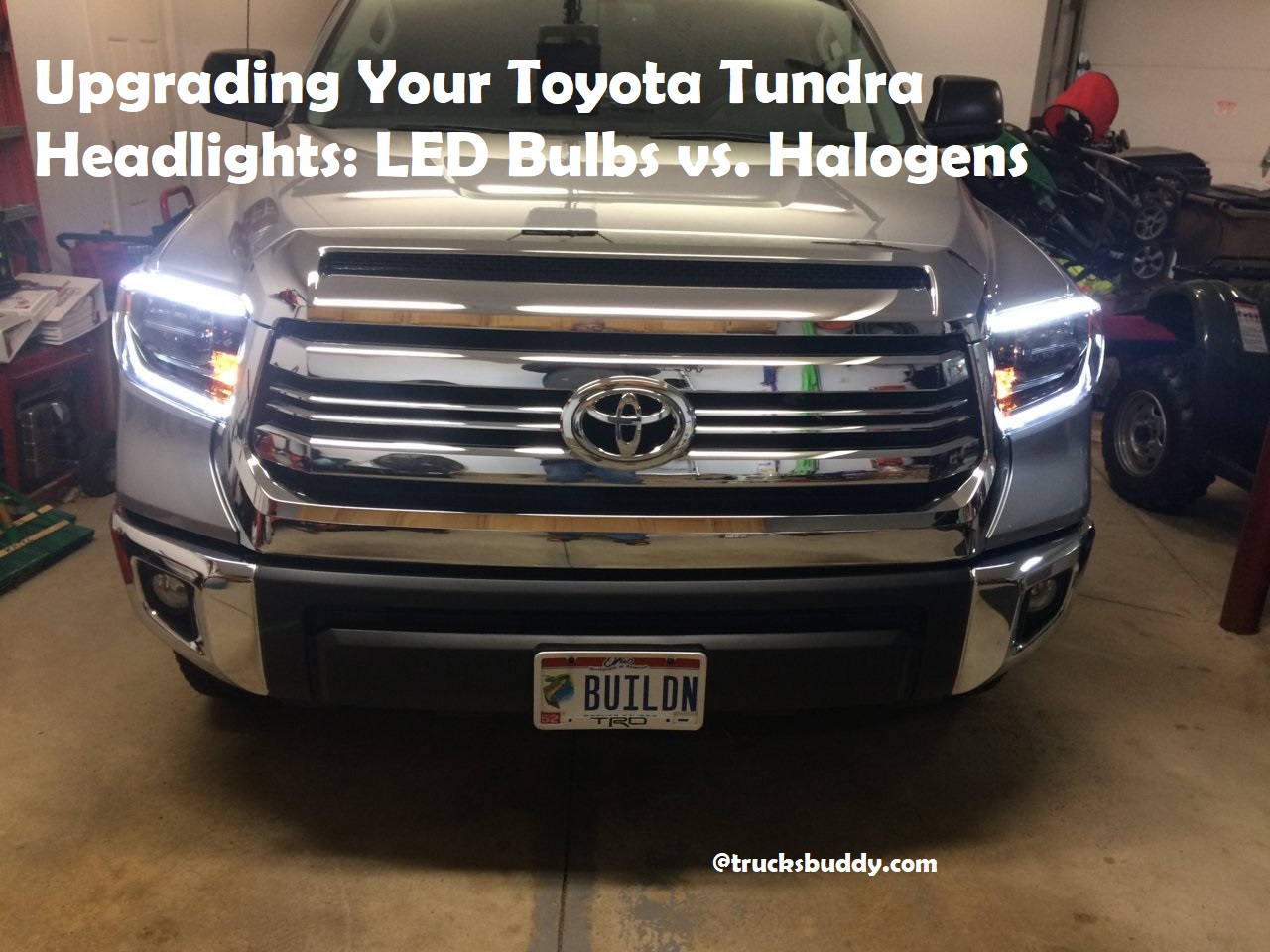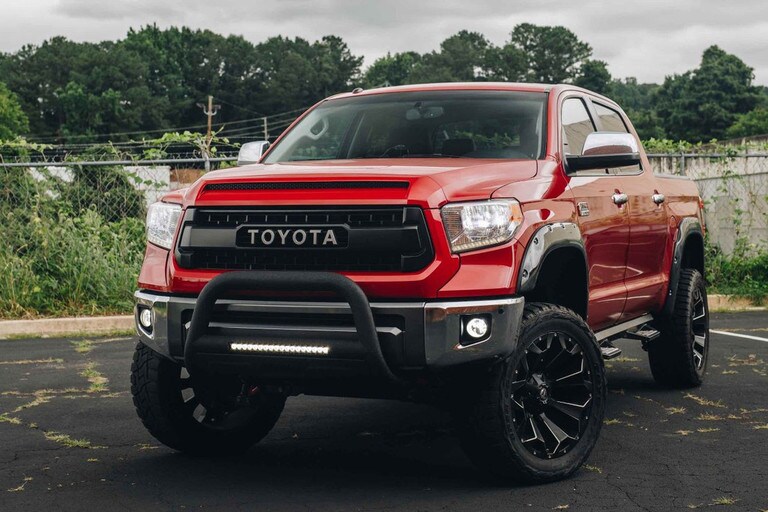Have you been searching for the perfect upgrade for your Toyota Tundra headlights? You are in luck!
This complete guide will help you compare LED bulbs vs. halogens so that you can make an informed decision about the best new headlight upgrade for your vehicle.
Upgrading the headlights of your Toyota Tundra is a great way to improve visibility, safety and style. To help you choose the best solution for your needs, this guide compares LED headlight bulbs with their halogen counterpart.
It covers some key technical points, such as wattage and bulb type, as well as discussing some practical considerations – such as installation techniques and compatibility – that you should consider when upgrading your Toyota Tundra headlights.
We will start by introducing LED and halogen bulbs, then compare their benefits and drawbacks before concluding with an overview of the advantages that LED bulbs offer over halogens.
Explanation of the importance of upgrading headlights
Upgrading your Toyota Tundra headlights is beneficial for both safety and style. With today’s technology and selection of bulbs, it is possible to significantly improve the illumination output of your truck’s headlights. This article will provide an overview of two common types of headlight bulbs – LED and Halogen – to help you make an informed choice when upgrading your Tundra’s headlights.
LED lights are popular because they last much longer than halogen bulbs, have a better color temperature, don’t draw as much power from your vehicle’s battery, and offer greater design flexibility. LEDs also give off less heat than halogens which can reduce system stress and make them more efficient for double beam systems as found in many high-end vehicles today.
Halogens on the other hand remain the most popular type of headlight bulb because they are generally inexpensive, easy to install and provide very bright light output with a yellowish hue. These bulbs contain different gases than LEDs but will still offer good performance when installed properly. While they do not last as long as LEDs they can still last several years depending on how often you use them.
When upgrading your Toyota Tundra headlights it is important to consider what type of bulb would best suit your needs before making a purchase decision. Be sure to research any additional hardware that might be needed for installation, such as wiring harnesses or brackets, to ensure that you have everything you need ahead of time before beginning work on the upgrade project.
Brief overview of LED bulbs and halogens
When you are looking to upgrade your Toyota Tundra’s headlights, you have two main options — LED bulbs or halogen bulbs. To decide which type of headlight is best for your specific needs it helps to have an understanding of the difference between the two types.
LED bulbs, or light-emitting diode, are a type of semiconductor technology that produces light with very little power consumption. LEDs provide better illumination than halogen lights by illuminating a large area of the road without being too bright for oncoming drivers. They also require significantly less energy and generate far less heat than halogen lights. LED bulbs tend to last longer and can outlast their halogen counterparts by up to five times over!
Halogen headlights are by far the most common type of headlight used in today’s vehicles. These advanced incandescent lamps contain a special gas called a “halogen” that increases their illumination range and lifespan. Halogens provide good visibility but generate quite a bit of heat compared to LEDs which can potentially be damaging in certain applications such as when plastic headlight covers are used in vehicles. They also require more energy and typically have shorter lifespans than LEDs – often only lasting around 1,000 hours depending on environmental conditions and usage habits.
Halogen Headlights
Halogens are the most common type of Toyota Tundra headlights available. Halogens use an electrical current that passes through a tungsten filament housed in a sealed halogen bulb filled with either iodine or bromine vapor. This combination of elements, when heated, gives off light similar to light emitted by sunlight. Halogen headlights tend to be much brighter and more efficient than their predecessors, which consisted of sealed beams managed by external reflectors.
While not as efficient or sleek in design as LED bulbs, the relatively low cost and availability makes halogen headlights a popular choice for most drivers. Benefits of halogen headlights include:
- Cost: Purchasing and installing halogen headlights can be cost effective compared to other headlight types including LEDs.
- Brightness: Halogens last longer than incandescent bulbs and produce a bright white light compared to normal bulbs which tend to be yellowish in color.
- Durability: Compared to incandescent bulbs, halogens are highly durable – meaning they will last longer before needing replacement due to the strong casing protecting them from potential damage.
- Availability: Thanks to their affordability and popularity, most car parts stores carry different types of halogen bulbs – making them easy to use as replacements for broken or damaged headlight assembly components.
Explanation of halogen bulbs
Halogens bulbs, which have been around for centuries, are the most common type of headlight bulb used today. In general, most halogen bulbs put out enough light to keep drivers safe on the road. They are inexpensive and easy to replace, making them a preferred choice for many car owners.
The downside of halogen bulbs is that they can use up to three times as much power as a comparable LED or Xenon bulb, and they tend to diminish in brightness over time due to voltage losses in the filament. On the flip side, halogen bulbs produce a warmer yellow light that’s easier on the eyes than brighter whites and blues from Xenon or LED bulbs. Plus they can be found in virtually any auto store, making replacements relatively easy.
Halogens headlight bulbs also have an average lifespan of 500 hours before needing replacement.
Advantages and disadvantages of halogen headlights
When you’re in the process of upgrading your Toyota Tundra headlights, you’ll have to decide between LED bulbs or halogens. Halogen headlights are the most commonly found type of headlight bulbs in automobiles due to their affordability and their ability to provide good light while using a smaller amount of energy than other types of headlights. As with any upgrade, there are advantages and disadvantages that should be taken into consideration when selecting halogen bulbs for your Tundra’s headlights.
The advantages of halogen headlights include increased visibility when driving at night or in low-light conditions thanks to its higher output rate compared to standard incandescent bulbs. Its heat-resistant casing prevents overheating and makes for safer operation than other choices such as xenon lights since it won’t overheat and cause a potential fire hazard. Halogen headlight bulbs are also more durable than other types, and their typically long lifespan makes them cost-effective in the long run.
On the flip side, some drawbacks exist when considering halogen headlights for your Toyota Tundra. The whiter light that LED bulbs project makes them more attractive than yellowish glow that comes from traditional halogens which can make them appear harsh or too bright on certain roads, depending on their location. Additionally, they may create a glare effect which could be distracting while driving at night or early morning hours, reducing visibility significantly under certain conditions. Furthermore, with just 20 percent of the output power emitted as visible light leaving 80 percent wasted as infrared heat energy, they are less energy efficient than LEDs making them less desirable from an economic perspective as well as an environmental one.
III. LED Headlights
LED headlights are becoming increasingly popular among Toyota Tundra owners for their superior performance and long-term reliability. When choosing an LED headlight for your Tundra, you will find a variety of models to choose from. Some common types of LED headlights include H7, H11/H9/H8, 9005/HB3 , and 9012/HIR2.
The bulbs themselves range in size and power output. Bulb sizes range from low-profile versions that can fit into the existing headlight assembly to larger versions that offer additional light output in exchange for greater power draw on the vehicle’s electrical system. The higher power output also means a more focused beam pattern which penetrates further down the road than what a halogen bulb could provide.
Power output is measured in lumens and you should look for bulbs with at least 3000 lumens of total light output. This may seem excessively bright but the wider beam pattern ensures that light dispersion is even throughout your field of view while still providing ample distance lighting capabilities without blinding oncoming traffic.
In addition to improved brightness, LED headlights offer benefits such as lower energy consumption, longer life span, and improved durability as they are less susceptible to vibrations when driving on off road terrain compared to halogen bulbs.
Explanation of LED bulbs
LED bulbs are rapidly becoming the preferred choice for Toyota Tundra headlights, with good reason. LEDs have a much longer life than halogen bulbs, up to 50,000 hours compared to 1,500 hours. The durability of LED lights makes them last significantly longer and means they are less likely to need frequent replacements.
Additionally, LED lights can take on more intensity without creating more heat – making them ideal for high-output lighting systems that require a lot of light without generating too much heat. LED headlights also consume less energy than halogen bulbs, so they are much more efficient.
Finally, LED lights come in an array of different colors and shades to choose from – so you can choose the color that’s best for you or switch it out later if you don’t like what you see after the initial install.
Advantages and disadvantages of LED headlights
Upgrading the headlights on your Toyota Tundra is a great way to improve the look of your truck and increase visibility during nighttime driving. The two most popular choices for headlight upgrades are LED bulbs and traditional halogen bulbs. Both styles have advantages and disadvantages that you should consider before making a purchase.
Advantages of LED Bulbs: -LED bulbs provide brighter light than halogen bulbs due to their more efficient technology. -LEDs produce almost no heat, so they can be used in close quarters safely. -They last significantly longer than halogen bulbs and are less prone to failure due to vibration or impacts. -They provide better visibility in off-road situations, as their beams penetrate further into darkness.
Disadvantages of LED Bulbs: -LED headlight conversions are significantly more expensive than traditional halogens and require a conversion kit for installation. -Installation time is longer as it requires mounting components for the LED kit as well as diagnosing the power cables for correct polarity. -The performance of LED headlight kits can vary greatly depending on manufacturer so it’s important to read reviews when choosing one for installation in your Toyota Tundra.
Comparing LED Bulbs vs. Halogens
When you upgrade your Toyota Tundra headlights, you have two choices- LED bulbs or halogen bulbs. LED bulbs are often higher quality and provide greater performance and longer life span than halogen bulbs. However, it is important to understand the differences between the two to ensure you purchase the right type of lights for your Tundra.
LED Bulbs: LED bulbs are quickly becoming an industry standard because they offer a wide range of benefits, such as greater durability and efficiency. They also produce brighter light that illuminates farther down the road than most halogen headlights. Additionally, they use fewer watts, which means you get more mileage out of each battery charge before needing to replensih it with a rechargeable battery pack or generator.
Halogens: Halogens produce a soft yellow-orange glow enough for adequate forward lighting in low light conditions but not quite enough for higher speed driving due to their natural blurriness. They’re generally cheaper than LEDS but don’t last anywhere near as long and may require frequent replacements if used frequently on longer trips at night or in high speeds over bumps. Furthermore, since halogens are electric based, these headlights don’t produce enough heat-resistant energy from fast/hot friction which can cause them to flicker when subject to heavy vibration like heavy off-road driving on rough terrain or washboards.
Brightness and visibility
When replacing the headlight bulbs on your Toyota Tundra, there are two major choices to consider: LED bulbs and halogens. LED light-emitting diodes have many advantages over traditional halogen bulbs, such as increased brightness and visibility, greater efficiency, and easier installation. Here is a guide listing all of the differences between the two types of headlights so that you can make an informed decision when upgrading your vehicle.
Brightness and visibility: LEDs are capable of producing significantly more light than halogens, which makes for better overall nighttime visibility on the road. They produce a brighter white beam that cuts through darkness more efficiently than halogen headlights do. Halogen headlights may still be adequate for some people who drive mainly during the day, but LEDs provide superior nighttime visibility and safety.
Efficiency: LEDs are up to 70% more efficient than halogen headlights in terms of converting electricity into light energy. This means they use much less power while producing a far brighter output than regular bulbs, making them an ideal choice if you’re looking to maximize performance while staying eco-friendly.
Installation: LEDs can be installed quickly and easily with no tools necessary – just follow the manufacturer’s instructions and you’ll be done in no time! Halogen bulbs can also be replaced quickly but will require basic tools such as wrenches to get the job done properly.
Energy efficiency and lifespan
The next key difference between LED and halogen headlights is their energy efficiency and lifespan. Halogen headlights tend to require more energy to produce light—meaning they draw more power from your vehicle’s battery. On the other hand, LED bulbs have a much lower watt draw, allowing your engine to use its energy for other purposes like accelerating or operating accessories.
Additionally, LEDs have a significantly longer life than halogens—the rated lifespan of LEDs is often 3-5 times that of halogens. This means you won’t have to change the bulbs as frequently, which in turn saves you time and money on maintenance costs.
Conclusion
As we discussed in this guide, upgrading your Toyota Tundra headlights with LED bulbs or halogens can make a big difference to your vehicle’s look and feel. LEDs are the clear winner when it comes to providing bright light with minimal power draw and low cost. However, they require some technological know-how to install, while halogens are an easier installation. LEDs tend to be much more expensive than halogens but provide superior visibility and longevity in comparison.
Ultimately, the decision of which type of headlight bulb is right for you will depend on your personal preferences, budget, and abilities. Whatever you decide, keeping your Toyota Tundra’s headlights up-to-date is essential for safety. Carefully weigh all the factors before making a decision so you can choose the best option for you.
FAQ’s
Are halogen better than LED for headlights?
It depends on personal preference and the specific application.
Can you use LED bulbs instead of halogen in headlights?
It is possible, but it may require modifications to the headlight housing and wiring.
Is it worth changing from halogen to LED?
It depends on the individual’s needs and preferences. LED headlights offer advantages such as increased brightness and energy efficiency.
What are the disadvantages of LED headlights?
LED headlights can be more expensive than halogen headlights and may require modifications to the vehicle’s electrical system.
What are the disadvantages of halogen headlights?
Halogen headlights are less energy-efficient and have a shorter lifespan than LED headlights.
Are LED headlights much brighter than halogen?
Yes, LED headlights are generally brighter than halogen headlights.
Can I legally upgrade my headlights to LED?
It depends on the laws and regulations in your area. Some jurisdictions allow LED headlight upgrades, while others do not.
Which headlights are best for night driving?
LED headlights are generally considered the best for night driving due to their brightness and clarity.
Why is LED light preferred over halogen bulb?
LED lights are preferred over halogen bulbs because they are more energy-efficient, have a longer lifespan, and produce brighter light.
What is the advantage of LED over halogen?
The advantages of LED over halogen include increased energy efficiency, longer lifespan, and brighter light output.
See Also-
- Best mud flaps for toyota tundra
- Best truck tent for toyota tundra
- Best accessories for toyota tundra
- Best upgrades for toyota tundra
- Best tuner for toyota tundra

